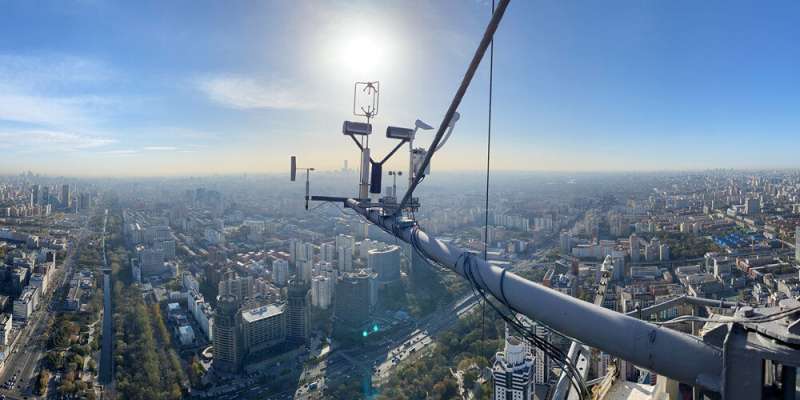A photo of haze over Beijing. Also shown are the instruments of four-cup anemometers, meteoprobe, ultrasonic anemometer and visibility meter installed on the Beijing 325 m meteorological tower. Credit: Li Hao
As the major absorbing aerosol, black carbon exerts positive radiative forcing on the atmosphere and affects the radiation balance of the earth-atmosphere system and hence aerosol-boundary interactions.
Although air quality in Beijing has been improved significantly since the implementation of the Clean Air Action Plan in 2013, the long-term changes in black carbon and optical properties of aerosols and their impacts are poorly known.
Prof. Sun Yele and his team from the Institute of Atmospheric Physics (IAP) of the Chinese Academy of Sciences conducted nine-year measurements of black carbon and light extinction coefficient in Beijing from 2012 to 2020.
By analyzing the long-term changes in black carbon, single-scattering albedo, mass extinction efficient, brown carbon and absorption Angstrom exponent, they demonstrated the response of black carbon and optical properties to the Clean Air Action Plan, and evaluated the impacts of black carbon and brown carbon on direct radiative forcing.
This study was published in Atmospheric Chemistry and Physics.
The researchers found that black carbon decreased by approximately 71% during the last decade in Beijing and the decreases were different in different seasons. The black carbon showed the most significant reductions in autumn and at night due to the decreased emissions in biomass burning and heavy-duty vehicles.
"The particle extinction coefficient that is directly related to visibility also decreased by 47%. Our results supported that the Clean Air Action Plan works in mitigating air pollution in Beijing," said Prof. Sun.
However, different changes in black carbon and extinction coefficient have caused increases in single-scattering albedo and mass extinction efficient. That is, scattering aerosols are more important in affecting aerosol radiative forcing. "The increased mass extinction efficient might not be a good sign because it will bring new challenges to improve atmospheric visibility in Beijing in the future," said Prof. Sun.
According to the study, the changes in black carbon, brown carbon and aerosol optical properties have significant implications in changing their radiative effects and aerosol-boundary layer interactions. Future mitigation of air pollution in megacities need to take these changes into account.
More information: Jiaxing Sun et al, Measurement report: Long-term changes in black carbon and aerosol optical properties from 2012 to 2020 in Beijing, China, Atmospheric Chemistry and Physics (2022). DOI: 10.5194/acp-22-561-2022
Journal information: Atmospheric Chemistry and Physics
Provided by Chinese Academy of Sciences
























